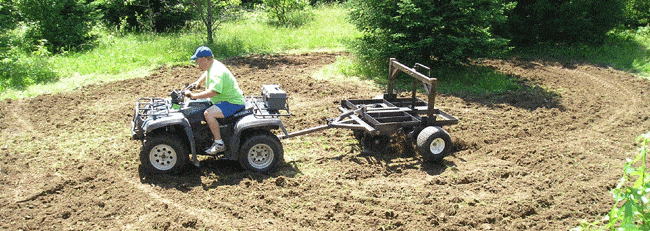Big Game Logic is reader-supported. When you buy through links on our site, we may earn an affiliate commission.
With the popularity of deer hunting at all-time highs; restrictions on baiting getting stronger and stronger; and, with the lack of access to prime hunting land, lots of deer hunters are trying to draw deer into their areas by building food plots.
Some things to consider in building food plots include where should the food plot be located, and how can it be accessed? How big should it be? Is the amount of land available too small to draw deer in? All good questions and all need to be answered.
Lots of people own land, but it's not typically great deer-hunting land, which classically consists of cedar swamps, tag alder thickets (where deer will bed), or agricultural land with crop fields which attract deer for feeding. Hunters with this kind of "primo" land don't have to worry about seeing deer, and they won't need a food plot. Thickets will provide bedding, and ag fields are great because they have beans, peas, corn and alfalfa.

The hunter that owns "in between" land, such as semi-clearcut hardwood areas, may or may not find deer passing through to get from point A (bedding area) to point B (feeding area). These are the hunters who should plant a food plot and you don't have to be a millionaire to do so.
A good working-size for a food plot will range from about a quarter acre to an acre. Clear the area of stumps and debris as best you can. Maybe rent or borrow a piece of heavy equipment or use a tiller or four wheeler to help with the work. There is actually specifically-designed equipment for putting in food plots, but, frankly, most folks simply can't afford it. Not everyone is Bill Gates -- and I don't think he even hunts! But you can still get it done.
Once the area is cleared, get a soil sample and take it to a chemist or feed mill to have it analyzed. You've got to know the level of acidity in the soil. Depending on the level of acidity, you'll have to infuse lime into the soil -- and a feed mill will usually be able to tell you how much lime you'll need to put in and, by the way, it's usually a LOT MORE lime than you might think. Once liming is done, you then plant.
Don't try to emulate the farmer with his corn, peas, beans or alfalfa.
Indeed, why "compete" when you can do BETTER?!! Food in deer plots should be different than ag products. There are specific deer food seeds that will not only draw in the deer, but because they are HIGH NUTRIENT, HIGH PROTEIN feeds, the deer who come to your plot will grow bigger, and faster, and healthier, with some real "racks" produced.
As for when to plant it's your choice. It depends on when your deer season starts, and how mature you want the food. Some hunters plant in May or June -- and the crop will take until deer season to mature.
Some plant in August, because they want the fresh, new green sprouts to attract the deer in the fall when the hunt is on. Another positive about late-season planting is that the food will sustain the deer in the winter, and will draw the deer back the NEXT SEASON, because they'll recognize a good food source; and, being creatures of habit, will return every year.
Because farmers harvest their crops in the fall, another trick some hunters use is to plant a perennial food; something like a winter rye, which will be there throughout the winter and keep the deer in your area constantly.
What all of this hard work does for the hunter who plants a food plot is success. He's no longer the guy in the middle waiting for deer to pass through. With the food plot, the deer are coming TO HIM OR HER directly, and, once there, will often become permanent residents of his particular area.
You don't have spend a lot of money planting a successful food plot. Do your homework and be proactive. If you follow through, chances are you may very well be exhibiting a big rack over the fireplace next season.
